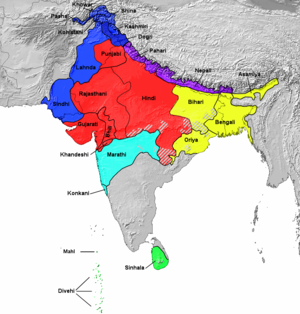Usuari:Davidpar/Bengalí
History[modifica]



Like other Eastern Indo-Aryan languages, Bengali arose from eastern Middle Indo-Aryan dialects of the Indian subcontinent. Magadhi Prakrit and Pali, the earliest recorded spoken languages in the region and the language of Gautama Buddha, evolved into the Jain Prakrit or Ardhamagadhi "Half Magadhi" in the early part of the first millennium CE.[1][2] Ardhamagadhi, as with all of the Prakrits of North India, began to give way to what are called Apabhraṃśa ("Corrupted grammar") languages just before the turn of the first millennium.[3] The local Apabhraṃśa language of the eastern subcontinent, Purvi Apabhraṃśa or Abahatta ("Meaningless Sounds"), eventually evolved into regional dialects, which in turn formed three groups: the Bihari languages, the Oriya languages, and the Assamese-Bengali languages. Some argue that the points of divergence occurred much earlier—going back to even 500[4] but the language was not static: different varieties coexisted and authors often wrote in multiple dialects. For example, Magadhi Prakrit is believed to have evolved into Abahatta around the 6th century which competed with the ancestor of Bengali for a period of time.[5]
Usually three periods are identified in the history of Bengali:[3]
- Old Bengali (900/1000–1400)—texts include Charyapada, devotional songs; emergence of pronouns Ami, tumi, etc.; verb inflections -ila, -iba, etc. Assamese (Axomiya) branches out in this period and Oriya just before this period (8th century-1300). The scripts and languages during this period were mainly influenced by the Kamrupi language (script-Kamrupa Prakrit) as the entire region- Assam, Bengal and parts of Bihar and Orissa was under the Kamrupa kingdom (now known as Assam).
- Middle Bengali (1400–1800)—major texts of the period include Chandidas's Shreekrishna Kirtana; elision of word-final ô sound; spread of compound verbs; Persian influence. Some scholars further divide this period into early and late middle periods.
- New Bengali (since 1800)—shortening of verbs and pronouns, among other changes (e.g. tahar → tar "his"/"her"; koriyachilô → korechilo he/she had done).
- ↑ Shah 1998, p. 11
- ↑ Keith 1998, p. 187
- ↑ 3,0 3,1 (Bhattacharya 2000) Error de citació: Etiqueta
<ref>no vàlida; el nom «tb» està definit diverses vegades amb contingut diferent. - ↑ (Sen 1996)
- ↑ Abahattha in Asiatic Society of Bangladesh 2003
